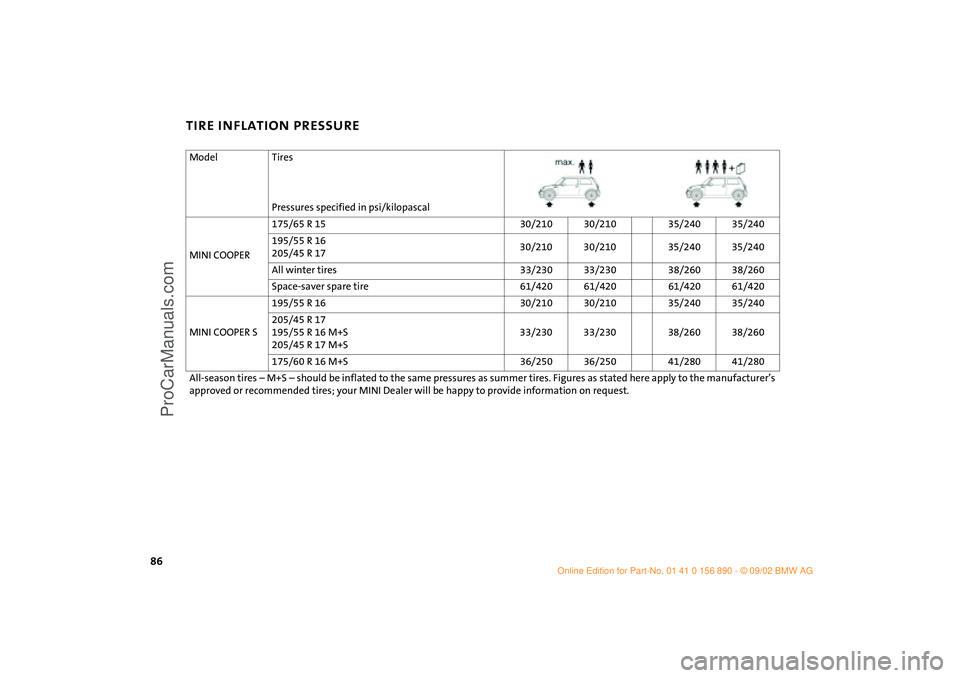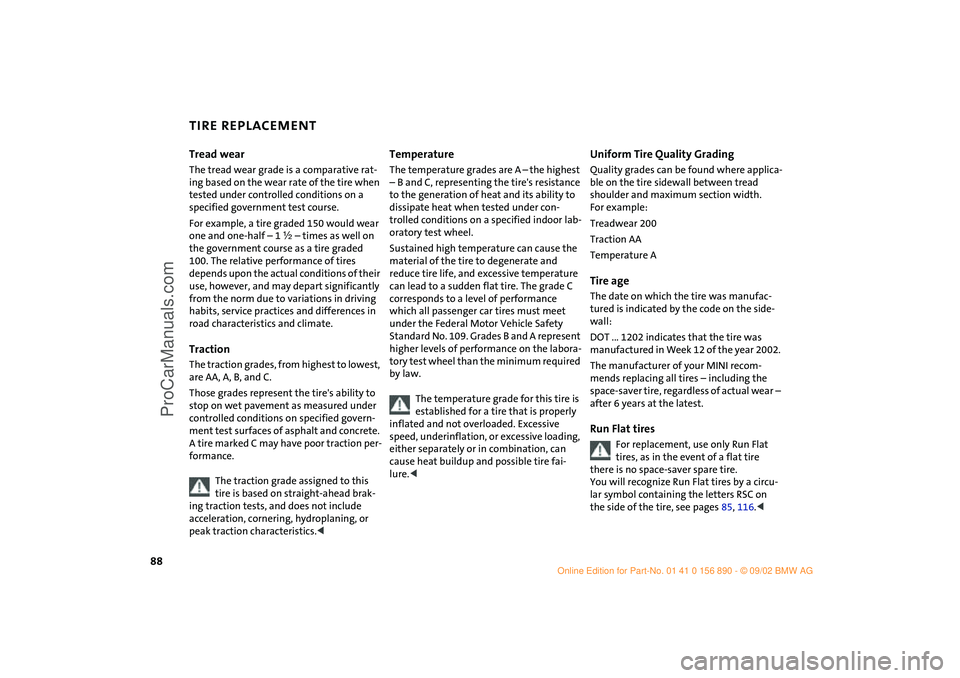MINI COOPER 2003 Manual Online
Manufacturer: MINI, Model Year: 2003, Model line: COOPER, Model: MINI COOPER 2003Pages: 148, PDF Size: 3.17 MB
Page 81 of 148

OVERVIEW
CONTROLS
OPERATION, CARE, MAINTENANCE
OWNER SERVICE PROCEDURES
INDEX TECHNICAL DATA
79
OVERVIEW REPAIRSOPERATIONCONTROLS DATA INDEX
Operation
ba.book Seite 79 Montag, 5. August 2002 8:09 20
ProCarManuals.com
Page 82 of 148

80
BREAK-IN PROCEDURESTo ensure that your vehicle provides maxi-
mum economy throughout a long service
life, we request that you comply with the
following information: EngineUp to 1,250 miles / 2,000 km:
Constantly vary both vehicle and engine
speed during these initial miles while
remembering not to exceed 4,500 rpm /
4500/min and/or vehicle speeds of over
95 mph / 150 km/h.
Absolutely avoid using the full-throttle or
kickdown position for the accelerator.
After 1,250 miles / 2,000 km, the rpm and
vehicle speed can be increased gradually.
You should also comply with these break-in
procedures if the engine has to be replaced
at a later point.
TiresDue to technical factors associated with
their manufacture, tires do not achieve
their full traction potential until after an
initial break-in period. Therefore drive care-
fully during the first 200 miles / 300 km.Brake systemApprox. 300 miles / 500 km must be driven
before the brake pads and rotors achieve
the optimum pad-surface and wear pat-
terns required for trouble-free operation
and an extended service life.ClutchRoughly 300 miles / 500 km must be driven
before the clutch starts to operate at opti-
mum efficiency. Remember to engage the
clutch carefully during this initial period.
ba.book Seite 80 Montag, 5. August 2002 8:09 20
ProCarManuals.com
Page 83 of 148

81
OVERVIEW REPAIRSOPERATIONCONTROLS DATA INDEX
GENERAL DRIVING NOTES Parking the vehicleCondensation forms in the air conditioner
system during operation, and then exits
under the vehicle. Traces of condensed
water on the ground are therefore normal.Brakes
Do not rest your foot on the brake
pedal while driving. Even light but
consistent pedal pressure can lead to high
temperatures, brake wear and possibly
even brake failure.<
Hydroplaning
When driving on wet or slushy roads,
reduce road speed. If you do not, a
wedge of water can form between tires and
road surface. This phenomenon is charac-
terized by a partial or complete loss of con-
tact between the tires and the road surface.
The ultimate results are loss of steering and
braking control.<
Driving through water
Do not drive through water on the
road if it is deeper than 1 ft / 30 cm,
and then only at walking speed at the
most. Otherwise, the vehicle's engine, the
electrical systems and the transmission
may be damaged.<
Clothes hooks
When suspending clothing from the
hooks, ensure that they will not
obstruct the driver's vision. Do not hang
heavy objects on the hooks. If you do so,
they could cause personal injury during
braking or evasive maneuvers.<
High temperatures
High temperatures occur in any vehi-
cle equipped with a catalytic con-
verter. Do not remove the heat protection
plates fitted in the area of the exhaust sys-
tem and do not apply body-cavity pro-
tectant to this area. When driving, standing
at idle or parking the vehicle, take care to
avoid contact between the hot exhaust sys-
tem and flammable materials – e.g. hay,
leaves, grass, etc. Such contact could lead
to a fire resulting in serious personal injury
and property damage.<
ba.book Seite 81 Montag, 5. August 2002 8:09 20
ProCarManuals.com
Page 84 of 148

82
REFUELING
Always switch off the engine before
refueling. If you do not, fuel cannot
be filled into the tank and the "Service
Engine Soon" lamp may come on.<
1. Open the fuel filler door
2. Turn the filler cap counterclockwise
3. Put the filler cap in the bracket attached
to the fuel filler door.
Always observe all applicable precau-
tions and regulations when handling
fuels. Never carry spare fuel containers in
your vehicle. Whether empty or full, these
containers can leak, cause an explosion,
and lead to fire in the event of a collision.<
Simple and environmentally friendly
Always observe all safety precautions
posted at the service station when
handling fuel.<
When refueling, insert the filler nozzle
completely into the filler pipe. Pulling the
nozzle out of the pipe during refueling
>results in premature pump shutoff
>will reduce the effect of the fuel vapor
recovery system on the pump.
As long as the filler nozzle is used properly,
the fuel tank is full whenever the nozzle
shuts off the first time.
Close tank:
1. Put on filler cap
2. Turn filler cap clockwise until it clicks
3. Close fuel filler door.
Fuel tank capacity:
approx. 13.2 gallons / 50 liters, of which
approx. 2.1 gallons / 8 liters are reserve
capacity.
Close the filler cap carefully after
refueling until a click is heard.
While closing, be sure not to squeeze the
strap which is fastened to the filler cap.
US models only:
A loose or missing cap will activate the
message CHECK FILLER CAP in the Check
Control* or the Check Filler Cap lamp
*.<
Do not drive until the fuel tank is
totally empty, otherwise engine oper-
ations are not guaranteed and damage
could occur.<
ba.book Seite 82 Montag, 5. August 2002 8:09 20
ProCarManuals.com
Page 85 of 148

83
OVERVIEW REPAIRSOPERATIONCONTROLS DATA INDEX
FUEL SPECIFICATIONS ANTILOCK BRAKE SYSTEM (ABS)The engine uses lead-free gasoline only.
Required fuel:
>Premium Unleaded Gasoline,
min. 91 AKI.
AKI = Anti Knock Index.
Do not use leaded fuels. The use of
leaded fuels will cause permanent
damage to the emissions-control system's
oxygen sensor and the catalytic con-
verter.<
The concept The ABS keeps the wheels from locking
while braking, thereby enhancing active
driving safety.
ABS also includes Electronic Brake Force
Distribution (EBD).Braking with ABSTo achieve optimal performance from ABS
when reacting to critical situations, you
should apply maximum pressure to the
brake pedal – panic stop.
Since the vehicle remains maneuverable,
you can still go around any obstacles with
the smallest possible steering movements.
Pulsation of the brake pedal in conjunction
with the sound of hydraulic regulation indi-
cates to you that you are driving at the limit
and reminds you to readapt your vehicle's
speed to road surface conditions.
Electronic Brake Force Distribution
(EBD)The system regulates the brake force distri-
bution between the front and rear axles. In
order to avoid an over-braking of the rear
wheels in certain situations, the EBD per-
manently monitors the slip values and reg-
ulates the slip on the rear axle depending
on that of the front axle.
ba.book Seite 83 Montag, 5. August 2002 8:09 20
ProCarManuals.com
Page 86 of 148

84
BRAKE SYSTEMBrake fluid level If the brake fluid level is too low and brake
pedal travel has become longer, there may
be a defect in one of the brake system's
hydraulic circuits.
Proceed to the nearest MINI Dealer.
Higher brake application pressure
may be necessary under these conditions,
there may be a slight pull to one side, and
brake pedal travel may be longer. Please
remember to adapt your driving style
accordingly.<
Disc brakesWhen the vehicle is driven only occasion-
ally, during extended periods when the
vehicle is not used at all, and in operating
conditions where brake applications are
less frequent, there is an increased ten-
dency for corrosion of the brake rotors and
accumulation of contamination on the
brake pads. This occurs because the mini-
mal pressure that must be exerted by the
pads to clean the rotors by brake applica-
tions is not reached.
Corrosion on brake rotors is signaled by a
running or pulsation during braking; even
extended subsequent braking will not cure
this phenomenon.
It is a good idea to periodically dry the
brakes with a gentle application when driv-
ing in rain and on wet roads. Monitor traffic
conditions to ensure that this maneuver
does not endanger other road users. The
resulting heat dries the brake rotor and the
brake pads. Then if braking effect is
needed, it is immediately available.
Extended or steep mountain descents
should be driven in the gear or in the driv-
ing position in which only minimal periodic
brake application is required. This helps
avoid placing excessive loads on the brake system. Stay within the allowable speed
range, refer to page 58.
Do not coast with the clutch pressed
or with the transmission or selector
lever in Neutral. Do not coast with the
engine switched off. The engine provides
no braking effect when the transmission is
in Neutral, and there is no power-assist for
braking when the engine is switched off.<
Brake pads
For your own safety: use brake pads
which the manufacturer of your MINI
has approved for your particular vehicle
model. The manufacturer of your MINI can-
not evaluate non-approved brake pads to
determine if they are suitable for use, and
therefore cannot ensure the operating
safety of the vehicle in the event of their
use.<
ba.book Seite 84 Montag, 5. August 2002 8:09 20
ProCarManuals.com
Page 87 of 148

85
OVERVIEW REPAIRSOPERATIONCONTROLS DATA INDEX
TIRE INFLATION PRESSUREInformation for your safetyThe factory-approved radial tires are
matched to the vehicle and have been
selected to provide optimum safety and
driving comfort if used properly.
It is not merely the tire's service life, but
also driving comfort and – above all else –
driving safety that depend on the condition
of the tires and the maintenance of the
specified tire pressure.
Incorrect inflation pressure is a frequent
cause of tire damage. It also significantly
influences the roadholding ability of your
MINI.
Check tire inflation pressures regu-
larly – at least every two weeks and
before beginning a longer trip. Failure to
observe these precautions can result in
incorrect tire pressures, which cause unsta-
ble handling response as well as tire dam-
age, and can ultimately lead to an accident.
Also check the inflation pressure on the
space-saver spare tire.
turer of your MINI, which can be asked for
from your MINI Dealer.
Inflation pressures are on a sticker attached
to the B-pillar and visible with the driver's
door open.Checking tire inflation pressuresAll pressures are specified in the standard
units of pressure for your country – psi/
kilopascal – and apply to cold tires, i.e. tires
at ambient temperature.
After correcting the tire inflation pressure,
reinitialize the Flat Tire Monitor, see
page 64.
Checking the inflation pressure on the
space-saver spare tireBehind the bumper there is a valve exten-
sion accessible from the outside for check-
ing the inflation pressure.Run Flat tiresRun Flat tires, available as an optional
extra, consist of self-contained tires and
special rims. The tire reinforcement
ensures that the tire retains residual safety
in the event of pressure drop, and driving
remains possible to a restricted degree. The
vehicle is equipped with a Flat Tire Monitor
which indicates a flat tire.
More information, see pages 64, 116.
ba.book Seite 85 Montag, 5. August 2002 8:09 20
ProCarManuals.com
Page 88 of 148

86
TIRE INFLATION PRESSUREModel Tires
Pressures specified in psi/kilopascal
MINI COOPER175/65 R 15 30/210 30/210 35/240 35/240
195/55 R 16
205/45 R 1730/210 30/210 35/240 35/240
All winter tires 33/230 33/230 38/260 38/260
Space-saver spare tire 61/420 61/420 61/420 61/420
MINI COOPER S195/55 R 16 30/210 30/210 35/240 35/240
205/45 R 17
195/55 R 16 M+S
205/45 R 17 M+S33/230 33/230 38/260 38/260
175/60 R 16 M+S 36/250 36/250 41/280 41/280
All-season tires – M+S – should be inflated to the same pressures as summer tires. Figures as stated here apply to the manufacturer’s
approved or recommended tires; your MINI Dealer will be happy to provide information on request.
ba.book Seite 86 Montag, 5. August 2002 8:09 20
ProCarManuals.com
Page 89 of 148

87
OVERVIEW REPAIRSOPERATIONCONTROLS DATA INDEX
TIRE CONDITION TIRE REPLACEMENTTire tread/tire damageInspect your tires frequently for tread wear,
signs of damage and for foreign objects
lodged in the tread. Check the tread depth.
The tread depth should not fall below1/8 in / 3 mm.
Below
1/8 in / 3 mm tread pattern depth,
there is an increased risk of hydroplaning,
even at relatively moderate speeds and
with only small amounts of water on the
road.
Wear indicators in the tread-groove base,
see arrow, are spread around the circum-
ference of the tire and are marked on the
side wall of the tire with TWI – Tread Wear
Indicator. The indicators in the tread indi-
cate at 1/16 in / 1.6 mm tread depth that
the legally permitted wear limit has been
reached.
Never continue to drive with a flat,
pressureless tire, except with Run Flat
tires. A pressureless, flat tire greatly
impairs steering and braking response, and
can lead to complete loss of control over
the vehicle. Avoid overloading the vehicle
so that the permitted load on the tires is
not exceeded. Overloading can lead to
overheating and increases the rate at
which damage develops inside the tires.
The ultimate result can assume the form of
a sudden air loss.
Unusual vibrations while driving, caused
for example by driving over a curb or simi-
lar, can indicate wheel or tire damage or
other damage to the vehicle. This is also
true for irregularities in the vehicle's han-
dling characteristics, such as a pronounced
tendency to pull to the left or right. Should
this occur, respond by immediately reduc-
ing your speed. Proceed carefully to the
nearest MINI Dealer or professional tire
center, or have the vehicle towed there to
have its wheels and/or tires inspected or
controlled. Tire damage – up to and includ-
ing blowouts – can endanger the lives of
both the vehicle occupants and other road
users.<
To maintain good handling and vehicle
response, use only tires of a single tread
configuration from a single manufacturer.
The manufacturer of your MINI tests and
approves wheel and tire combinations.
Do not use retreaded tires, since driv-
ing safety may be impaired. This is
due to the possible variations in casing
structures and, in some cases, to their
extreme age, which can lead to a decrease
in their durability.
Temperature A B C
All passenger car tires must conform
to Federal Safety Requirements in
addition to these grades.<
ba.book Seite 87 Montag, 5. August 2002 8:09 20
ProCarManuals.com
Page 90 of 148

88
TIRE REPLACEMENT Tread wearThe tread wear grade is a comparative rat-
ing based on the wear rate of the tire when
tested under controlled conditions on a
specified government test course.
For example, a tire graded 150 would wear
one and one-half – 1 γ – times as well on
the government course as a tire graded
100. The relative performance of tires
depends upon the actual conditions of their
use, however, and may depart significantly
from the norm due to variations in driving
habits, service practices and differences in
road characteristics and climate.TractionThe traction grades, from highest to lowest,
are AA, A, B, and C.
Those grades represent the tire's ability to
stop on wet pavement as measured under
controlled conditions on specified govern-
ment test surfaces of asphalt and concrete.
A tire marked C may have poor traction per-
formance.
The traction grade assigned to this
tire is based on straight-ahead brak-
ing traction tests, and does not include
acceleration, cornering, hydroplaning, or
peak traction characteristics.<
TemperatureThe temperature grades are A
– the highest
– B and C, representing the tire's resistance
to the generation of heat and its ability to
dissipate heat when tested under con-
trolled conditions on a specified indoor lab-
oratory test wheel.
Sustained high temperature can cause the
material of the tire to degenerate and
reduce tire life, and excessive temperature
can lead to a sudden flat tire. The grade C
corresponds to a level of performance
which all passenger car tires must meet
under the Federal Motor Vehicle Safety
Standard No. 109. Grades B and A represent
higher levels of performance on the labora-
tory test wheel than the minimum required
by law.
The temperature grade for this tire is
established for a tire that is properly
inflated and not overloaded. Excessive
speed, underinflation, or excessive loading,
either separately or in combination, can
cause heat buildup and possible tire fai-
lure.<
Uniform Tire Quality Grading Quality grades can be found where applica-
ble on the tire sidewall between tread
shoulder and maximum section width.
For example:
Treadwear 200
Traction AA
Temperature ATire age The date on which the tire was manufac-
tured is indicated by the code on the side-
wall:
DOT ... 1202 indicates that the tire was
manufactured in Week 12 of the year 2002.
The manufacturer of your MINI recom-
mends replacing all tires – including the
space-saver tire, regardless of actual wear –
after 6 years at the latest.Run Flat tires
For replacement, use only Run Flat
tires, as in the event of a flat tire
there is no space-saver spare tire.
You will recognize Run Flat tires by a circu-
lar symbol containing the letters RSC on
the side of the tire, see pages 85, 116.<
ba.book Seite 88 Montag, 5. August 2002 8:09 20
ProCarManuals.com